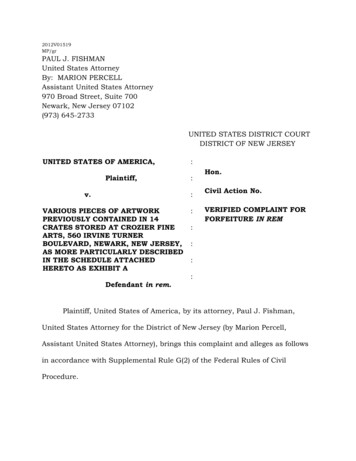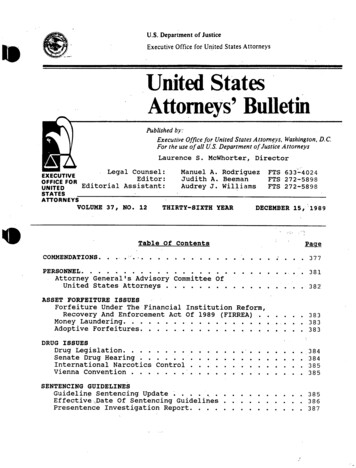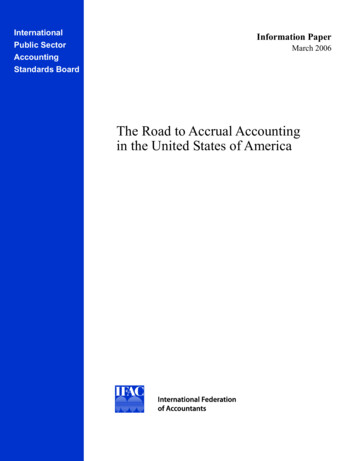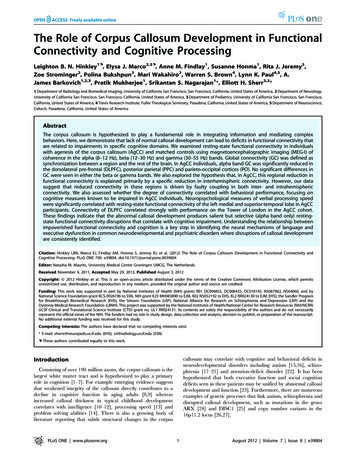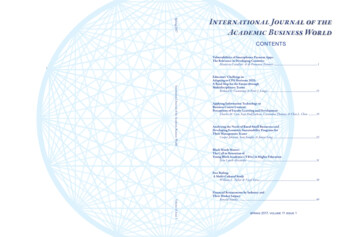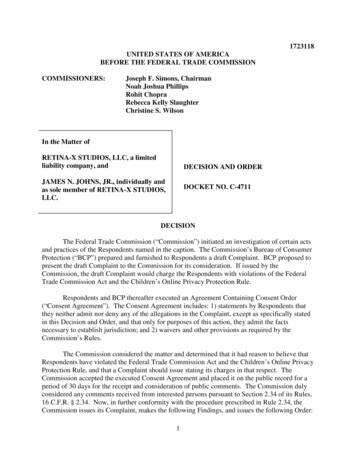
Transcription
1723118UNITED STATES OF AMERICABEFORE THE FEDERAL TRADE COMMISSIONCOMMISSIONERS:Joseph F. Simons, ChairmanNoah Joshua PhillipsRohit ChopraRebecca Kelly SlaughterChristine S. WilsonIn the Matter ofRETINA-X STUDIOS, LLC, a limitedliability company, andDECISION AND ORDERJAMES N. JOHNS, JR., individually andas sole member of RETINA-X STUDIOS,LLC.DOCKET NO. C-4711DECISIONThe Federal Trade Commission (“Commission”) initiated an investigation of certain actsand practices of the Respondents named in the caption. The Commission’s Bureau of ConsumerProtection (“BCP”) prepared and furnished to Respondents a draft Complaint. BCP proposed topresent the draft Complaint to the Commission for its consideration. If issued by theCommission, the draft Complaint would charge the Respondents with violations of the FederalTrade Commission Act and the Children’s Online Privacy Protection Rule.Respondents and BCP thereafter executed an Agreement Containing Consent Order(“Consent Agreement”). The Consent Agreement includes: 1) statements by Respondents thatthey neither admit nor deny any of the allegations in the Complaint, except as specifically statedin this Decision and Order, and that only for purposes of this action, they admit the factsnecessary to establish jurisdiction; and 2) waivers and other provisions as required by theCommission’s Rules.The Commission considered the matter and determined that it had reason to believe thatRespondents have violated the Federal Trade Commission Act and the Children’s Online PrivacyProtection Rule, and that a Complaint should issue stating its charges in that respect. TheCommission accepted the executed Consent Agreement and placed it on the public record for aperiod of 30 days for the receipt and consideration of public comments. The Commission dulyconsidered any comments received from interested persons pursuant to Section 2.34 of its Rules,16 C.F.R. § 2.34. Now, in further conformity with the procedure prescribed in Rule 2.34, theCommission issues its Complaint, makes the following Findings, and issues the following Order:1
Findings1. The Respondents are:a. Respondent Retina-X Studios, LLC, a Florida limited liability company with itsprincipal place of business at 731 Duval Station Road, Suite 107, Box 203,Jacksonville, Florida 32218.b. Respondent James N. Johns, Jr. the registered agent and sole member ofRespondent Retina-X Studios, LLC. Individually or in concert with others, heformulates, directs, or controls the policies, acts, or practices of Retina-X Studios,LLC. His principal place of business is the same as that of Retina-X Studios,LLC.2. The Commission has jurisdiction over the subject matter of this proceeding and over theRespondents, and the proceeding is in the public interest.ORDERDefinitionsFor the purpose of this Order, the following definitions apply:A. “Child” or “Children” means an individual under the age of 13.B. “Clear(ly) and Conspicuous(ly)” means that a required disclosure is difficult to miss (i.e.,easily noticeable) and easily understandable by ordinary consumers, including in all ofthe following ways:1. In any communication that is solely visual or solely audible, the disclosure mustbe made through the same means through which the communication is presented.In any communication made through both visual and audible means, such as atelevision advertisement, the disclosure must be presented simultaneously in boththe visual and audible portions of the communication even if the representationrequiring the disclosure is made in only one means.2. A visual disclosure, by its size, contrast, location, the length of time it appears,and other characteristics, must stand out from any accompanying text or othervisual elements so that it is easily noticed, read, and understood.3. An audible disclosure, including by telephone or streaming video, must bedelivered in a volume, speed, and cadence sufficient for ordinary consumers toeasily hear and understand it.4. In any communication using an interactive electronic medium, such as theInternet or software, the disclosure must be unavoidable.2
5. The disclosure must use diction and syntax understandable to ordinary consumersand must appear in each language in which the representation that requires thedisclosure appears.6. The disclosure must comply with these requirements in each medium throughwhich it is received, including all electronic devices and face-to-facecommunications.7. The disclosure must not be contradicted or mitigated by, or inconsistent with,anything else in the communication.8. When the representation or sales practice targets a specific audience, such asChildren, the elderly, or the terminally ill, “ordinary consumers” includesreasonable members of that group.C. “Collects” or “Collection” means, for the purposes of Provision III of this Order, thegathering of any Personal Information from a Child by any means, including but notlimited to:1. Requesting, prompting, or encouraging a Child to submit Personal Informationonline;2. Enabling a Child to make Personal Information publicly available in identifiableform; or3. Passive tracking of a Child online.D. “Covered Business” means Corporate Respondent, any business that CorporateRespondent controls, directly or indirectly, and any business that Individual Respondentcontrols, directly or indirectly.E. “Covered Incident” means any instance in which any United States federal, state, or locallaw or regulation requires a Covered Business or Individual Respondent to notify anyU.S. federal, state, or local government entity that information collected or received,directly or indirectly, by a Covered Business from or about an individual consumer was,or is reasonably believed to have been, accessed or acquired without authorization.F. “Disclose” or “Disclosure” means, with respect to Personal Information:1. The release of Personal Information Collected by an operator from a Child inidentifiable form for any purpose, except where an operator provides suchinformation to a person who provides Support for the Internal Operations of theWeb Site or Online Service; and3
2. Making Personal Information Collected by an operator from a Child publiclyavailable in identifiable form by any means, including but not limited to a publicposting through the Internet, or through a personal home page or screen posted ona Web site or online service; a pen pal service; an electronic mail service; amessage board; or a chat room.G. “Internet” means collectively the myriad of computer and telecommunication facilities,including equipment and operating software, which comprises the interconnected worldwide network of networks that employ the Transmission Control Protocol/InternetProtocol, or any predecessor or successor protocols to such protocol, to communicateinformation of all kinds by wire, radio, or other methods of transmission.H. “Jailbreak(ing) or Root(ing)” includes any action that bypasses a restriction by theMobile Device manufacturer or operating system.I. “Mobile Device” means any portable computing device that operates using a mobileoperating system, including but not limited to, any smartphone, tablet, wearable, orsensor, or any periphery of any portable computing device.J. “Monitoring Product or Service” means any software application, program, or code thatthat can be installed on a user’s Mobile Device to track or monitor that user’s activitieson the Mobile Device, including but not limited to, the user’s text messages, web browserhistory, geolocation, and photos.K. “Online Contact Information” means an email address or any other substantially similaridentifier that permits direct contact with a person online, including but not limited to, aninstant messaging user identifier, a voice over internet protocol (VOIP) identifier, or avideo chat identifier.L. “Operator” means any person who operates a Web site located on the Internet or anonline service and who Collects or maintains Personal Information from or about theusers of or visitors to such Web site or online service, or on whose behalf suchinformation is Collected or maintained, or offers products or services for sale through theWeb site or online service, where such Web site or online service is operated forcommercial purposes involving commerce among the several States, or with one or moreforeign nations; in any territory of the United States or in the District of Columbia, orbetween any such territory and another such territory or any State or foreign nation; orbetween the District of Columbia and any State, territory, or foreign nation.M. “Parent” includes a legal guardian.N. “Person” means any individual, partnership, corporation, trust, estate, cooperative,association, or other entity.O. “Personal Information” means individually identifiable information from or about anindividual consumer, including:4
1. A first and last name;2. A home or other physical address;3. An email address;4. A telephone number;5. A Social Security number;6. A driver’s license or other government issues identification number;7. A financial account number;8. Credit or debit card information;9. Date of birth;10. Online Contact Information as defined in 16 C.F.R. § 312.2;11. A screen or user name where it functions in the same manner as Online ContactInformation, as defined in 16 C.F.R. § 312.2;12. A persistent identifier that can be used to recognize a user over time and acrossdifferent Web sites or online services. Such persistent identifier includes, but isnot limited to, a customer number held in a cookie, an Internet Protocol (IP)address, a processor or device serial number, or unique device identifier;13. A photograph, video, or audio file;14. Geolocation information sufficient to identify street name and name of a city oftown; or15. Information concerning a Child or the parents of that Child that the OperatorCollects online from the Child and combines with an identifier described in thissection.P. “Respondents” means Corporate Respondent and Individual Respondent, individually,collectively, or in any combination.1. “Corporate Respondent” means Retina-X Studios, LLC, and its successors andassigns.2. “Individual Respondent” means James N. Johns, Jr.5
Q. “Support for the Internal Operations of the Web Site or Online Service” means:1. Those activities necessary to:a.Maintain or analyze the functioning of the Web site or online service;b.Perform network communications;c.Authenticate users of, or personalize the content on, the Web site or onlineservice;d.Serve contextual advertising on the Web site or online service or cap thefrequency of advertising;e.Protect the security or integrity of the user, Web site, or online service;f. Ensure legal or regulatory compliance; org. Fulfill a request of a Child as permitted by 16 C.F.R. §§ 312.5(c)(3) and(4).2. So long as the information Collected for the activities listed in paragraphs (1)(a) –(g) of this definition is not used or disclosed to contact a specific individual,including through behavioral advertising, to amass a profile on a specificindividual, or for any other purpose.R. “Web site or online service directed to Children” means a commercial Web site or onlineservice, or portion thereof, that is targeted to Children.1. In determining whether a Web site or online service, or a portion thereof, isdirected to Children, the Commission will consider its subject matter, visualcontent, user of animated characters or Child-oriented activities and incentives,music or other audio content, age of models, presence of Child celebrities orcelebrities who appeal to Children, language or other characteristics of the Website or online service, we well as whether advertising promoting or appearing onthe Web site or online service is directed to Children. The Commission will alsoconsider competent and reliable empirical evidence regarding audiencecomposition, and evidence regarding the intended audience.2. A Web site or online service shall be deemed directed to Children when it hasactual knowledge that it is Collecting Personal Information directly from users ofanother Web site or online service directed to Children.6
3. A Web site or online service that is directed to Children under this criteria setforth in paragraph (1) of this definition, but that does not target Children as itsprimary audience, shall not be deemed directed to Children if it:a. Does not Collect Personal Information from any visitor prior toCollecting age information; andb. Prevents the Collection, use, or disclosure or Personal Information fromvisitors who identify themselves as under age 13 without first complyingwith the notice and parental consent provisions of 16 C.F.R. Part 312,attached hereto as Appendix A.4. A Web site or online service shall not be deemed directed to Children solelybecause it refers or links to a commercial Web site or online service directed toChildren by using information location tools, including a directory, index,reference, pointer, or hypertext linkI.MONITORING PRODUCTS AND SERVICESIT IS ORDERED that Respondents, and Respondents’ officers, agents, employees, andattorneys, and all other persons in active concert or participation with any of them, who receiveactual notice of this Order, whether acting directly or indirectly, are permanently restrained andenjoined from, or assisting others in, promoting, selling, or distributing a Monitoring Product orService unless Respondents comply with the following:A. Mobile Device Security: No Monitoring Product or Service’s functionality may requirecircumventing security protections implemented by the Mobile Device operating systemor manufacturer, such as by Jailbreaking or Rooting a Mobile Device.B. Registration Attestation and Documentation: Prior to the sale or distribution of anyMonitoring Product or Service, Respondents must obtain:a. An express written attestation from the purchaser that it will use the MonitoringProduct or Service for legitimate and lawful purposes by authorized users.i. The express written attestation must state the legitimate and lawfulpurpose for which the purchaser is using the device, which may includeonly the following:1. Parent monitoring a minor Child;2. Employer monitoring an employee who has provided expresswritten consent to being monitored; or3. Adult monitoring another adult who has provided express writtenconsent to being monitored;7
ii. Respondents cannot provide purchasers with written attestation language;iii. Respondents cannot suggest, direct, or otherwise assist, purchasers insubmitting fraudulent written attestations; andb. Documentation proving that the purchaser is an authorized user on the monitoredMobile Device’s service carrier account.C. Icon Notice: The Monitoring Product or Service must display an application icon,accompanied by the name of the Monitoring Product or Service adjacent to theapplication icon. The consumer must be able to click on the application icon to a page onwhich Respondents present a Clear and Conspicuous notice stating:i. The name and material functions of the Monitoring Product or Service;ii. That the Monitoring Product or Service is running on the user’s MobileDevice; andiii. Where and how the user can contact Respondents for additionalinformation, or to resolve an issue of improper installation of theMonitoring Product or Service.b. Exception to the Icon Notice Requirement:i. Respondents may program the Monitoring Product or Service to allow thepurchaser of the Monitoring Product or Service to disable the Icon Noticeonly if the purchaser attests, prior to installation, that the purchaser is thelegal guardian or parent of a minor Child, and that the MonitoringSoftware or Product will be installed on a Mobile Device predominantlyused by the minor Child.II.ADDITIONAL WARNINGS AND NOTICESIT IS FURTHER ORDERED that Respondents, and Respondents’ officers, agents,employees, and attorneys, and all other persons in active concert or participation with any ofthem, who receive actual notice of this Order, whether acting directly or indirectly, arepermanently restrained and enjoined from, or assisting others in, promoting, selling, ordistributing Monitoring Products or Services unless Respondents provide the purchaser with thefollowing notices:A. Home Page Notice: The home page of any Internet website advertising the MonitoringProduct or Service must Clearly and Conspicuously provide notice that the MonitoringProduct or Service may only be used for legitimate and lawful purposes by authorizedusers, and that installing or using the Monitoring Product or Service for any other8
purpose may violate local, state, and/or federal law. The foregoing notice must be placedsuch that it can be viewed on the screen first seen by a potential purchaser who lands onthe home page.B. Purchase Page Notice: Respondents may not complete the sale of a Monitoring Productor Service unless Respondents provide the purchaser with Clear and Conspicuous noticethe Monitoring Product or Service may only be used for legitimate and lawful purposesby authorized users, and that installing or using the Monitoring Product or Service forany other purpose may violate local, state, and/or federal law.III.INJUNCTION CONCERNING THE COLLECTION OF PERSONALINFORMATIONIT IS FURTHER ORDERED that Respondents, and Respondents’ officers, agents,employees, and attorneys, and all other persons in active concert or participation with any ofthem, who receive actual notice of this Order, whether acting directly or indirectly, in connectionwith being an operator of any Web site or online service directed to Children or of any Web siteor online service with actual knowledge that it is Collecting or maintaining Personal Informationfrom a Child, are hereby permanently restrained and enjoined from violating the Children’sPrivacy Protection Rule, 16 C.F.R. Part 312, including but not limited to failing to establish andmaintain reasonable procedures to protect the confidentiality, security, and integrity of PersonalInformation from Children.A copy of the Children’s Online Privacy Protection Rule, 16 C.F.R. Part 312, is attachedhereto as Appendix A.IV.PROHIBITION AGAINST MISREPRESENTATIONSIT IS FURTHER ORDERED that Respondents, and Respondents’ officers, agents,employees, and attorneys, and all other persons in active concert or participation with any ofthem, who receive actual notice of this Order, whether acting directly or indirectly, in connectionwith any product or service, are hereby permanently restrained and enjoined frommisrepresenting, expressly or by implication, the extent to which Respondents maintain andprotect the privacy, security, confidentiality, or integrity of Personal Information.V. DATA DELETIONIT IS FURTHER ORDERED that within one hundred twenty (120) days after entry ofthis Order, Respondents and Respondents’ offers, agents, employees, and attorneys, and all otherpersons in active concert or participation with any of them, who receive actual notice of thisOrder, must destroy all Personal Information collected from a Monitoring Product or Serviceprior to entry of this Order. Provided, however, that such Personal Information need not bedestroyed, and may be disclosed, to the extent requested by a government agency or required bylaw, regulation, or court order, including without limitation as required by rules applicable to thesafeguarding of evidence in pending litigation.9
VI. MANDATED INFORMATION SECURITY PROGRAMIT IS FURTHER ORDERED that each Covered Business shall not transfer, sell, share,collect, maintain, or store Personal Information unless it establishes and implements, andthereafter maintains, a comprehensive information security program (“Information SecurityProgram”) that protects the security, confidentiality, and integrity of such Personal Information.To satisfy this requirement, each Covered Business must, at a minimum:A. Document in writing the content, implementation, and maintenance of the InformationSecurity Program;B. Provide the written program and any evaluations thereof or updates thereto to its board ofdirectors or governing body or, if no such board or equivalent governing body exists, to asenior officer responsible for its information security program at least once every twelvemonths and promptly after any Covered Incident;C. Designate a qualified employee or employees to coordinate and be responsible for theInformation Security Program;D. Assess and document, at least once every twelve months and promptly following aCovered Incident, internal and external risks to the security, confidentiality, or integrityof Personal Information that could result in the unauthorized disclosure, misuse, loss,theft, alteration, destruction, or other compromise of such information;E.Design, implement, maintain, and document safeguards that control for the internal andexternal risks to the security, confidentiality, or integrity of Personal Informationidentified in response to sub-Provision VI.D. Each safeguard shall be based on thevolume and sensitivity of the Personal Information that is at risk, and the likelihood thatthe risk could be realized and result in the unauthorized access, collection, use,alteration, destruction, or disclosure of the Personal Information. Respondents’safeguards shall also include:1. Technical measures to monitor all of Respondents’ networks and all systems andassets within those networks to identify data security events, including unauthorizedattempts to exfiltrate Personal Information from those networks;2. Technical measures to secure Respondents’ web applications and mobile applicationsand address well-known and reasonably foreseeable vulnerabilities, such as cross-sitescripting, structured query language injection, and other risks identified byRespondents through risk assessments and/or penetration testing;3. Data access controls for all databases storing Personal Information, including by, at aminimum, (a) requiring authentication to access them, and (b) limiting employee orservice provider access to what is needed to perform that employee’s job function;4. Encryption of all Personal Information on Respondents’ computer networks; and10
5. Establishing and enforcing policies and procedures to ensure that all service providerswith access to Respondents’ network or access to Personal Information are adheringto Respondents’ Information Security Program.F.Assess, at least once every twelve (12) months and promptly following a CoveredIncident, the sufficiency of any safeguards in place to address the risks to the security,confidentiality, or integrity of Personal Information, and modify the InformationSecurity Program based on the results.G.Test and monitor the effectiveness of the safeguards at least once every twelve monthsand promptly following a Covered Incident, and modify the Information SecurityProgram based on the results. Such testing shall include vulnerability testing of each ofRespondents’ network(s) once every four (4) months and promptly after any CoveredIncident, and penetration testing of each Covered Business’s network(s) at least onceevery twelve (12) months and promptly after any Covered Incident;H.Select and retain service providers capable of safeguarding Personal Information theyreceive from each Covered Business, and contractually require service providers toimplement and maintain safeguards for Personal Information; andI.Evaluate and adjust the Information Security Program in light of any changes toRespondents’ operations or business arrangements, a Covered Incident, or any othercircumstances that Respondents know or have reason to know may have an impact onthe effectiveness of the Information Security Program. At a minimum, each CoveredBusiness must evaluate the Information Security Program at least once every twelve(12) months and modify the Information Security Program based on the results.VII.INFORMATION SECURITY ASSESSMENTS BY A THIRD PARTYIT IS FURTHER ORDERED that, in connection with compliance with Provision VI of thisOrder titled Mandated Information Security Program, Respondents must obtain initial andbiennial assessments (“Assessments”):A.The Assessments must be obtained from a qualified, objective, independent third-partyprofessional (“Assessor”), who: (1) uses procedures and standards generally accepted inthe profession; (2) conducts an independent review of the Information SecurityProgram; and (3) retains all documents relevant to each Assessment for five (5) yearsafter completion of such Assessment and will provide such documents to theCommission within ten (10) days of receipt of a written request from a representative ofthe Commission. No documents may be withheld on the basis of a claim ofconfidentiality, proprietary or trade secrets, work product, attorney client privilege,statutory exemption, or any similar claim.B.For each Assessment, Respondents shall provide the Associate Director forEnforcement for the Bureau of Consumer Protection at the Federal Trade Commission11
with the name and affiliation of the person selected to conduct the Assessment, whichthe Associate Director shall have the authority to approve in his or her sole discretion.C.The reporting period for the Assessments must cover: (1) the first one hundred eighty(180) days after the issuance date of the Order for the initial Assessment; and (2) each2-year period thereafter for twenty (20) years after issuance of the Order for thebiennial Assessments.D.Each Assessment must: (1) determine whether each Covered Business has implementedand maintained the Information Security Program required by Provision VI of thisOrder, titled Mandated Information Security Program; (2) assess the effectiveness ofeach Covered Business’s implementation and maintenance of sub-Provisions VI.A-I;(3) identify any gaps or weaknesses in the Information Security Program; and (4)identify specific evidence (including, but not limited to, documents reviewed, samplingand testing performed, and interviews conducted) examined to make suchdeterminations, assessments, and identifications, and explain why the evidence that theAssessor examined is sufficient to justify the Assessor’s findings. No finding of anyAssessment shall rely solely on assertions or attestations by a Covered Business’smanagement. The Assessment shall be signed by the Assessor and shall state that theAssessor conducted an independent review of the Information Security Program, anddid not rely solely on assertions or attestations by a Covered Business’s management.E.Each Assessment must be completed within sixty (60) days after the end of thereporting period to which the Assessment applies. Unless otherwise directed by aCommission representative in writing, Respondents must submit the initial Assessmentto the Commission within ten (10) days after the Assessment has been completed viaemail to DEbrief@ftc.gov or by overnight courier (not the U.S. Postal Service) toAssociate Director for Enforcement, Bureau of Consumer Protection, Federal TradeCommission, 600 Pennsylvania Avenue NW, Washington, DC 20580. The subjectline must begin, “In re Retina-X Studios, LLC, FTC File No. 172 3118.” Allsubsequent biennial Assessments shall be retained by Respondents until the order isterminated and provided to the Associate Director for Enforcement within ten (10) daysof request.VIII.COOPERATION WITH THIRD PARTY INFORMATION SECURITYASSESSORIT IS FURTHER ORDERED that Respondents, whether acting directly or indirectly, inconnection with any Assessment required by Provision VII of this Order titled InformationSecurity Assessments by a Third Party, must:A. Disclose all material facts to the Assessor, and not misrepresent in any manner, expresslyor by implication, any fact material to the Assessor’s: (1) determination of whetherRespondents have implemented and maintained the Information Security Programrequired by Provision VI of this Order, titled Mandated Information Security Program;(2) assessment of the effectiveness of the implementation and maintenance of sub12
Provisions VI.A-I; or (3) identification of any gaps or weaknesses in the InformationSecurity Program; andB. Provide or otherwise make available to the Assessor all information and material in theirpossession, custody, or control that is relevant to the Assessment for which there is noreasonable claim of privilege.IX. ANNUAL CERTIFICATIONIT IS FURTHER ORDERED that in connection with compliance with Provision VI ofthis Order titled Mandated Information Security Program, Respondents shall:A. One year after the issuance date of this Order, and each year thereafter, provide theCommission with a certification from a senior corporate manager, or, if no such seniorcorporate manager exists, a senior officer of each Covered Business responsible for eachCovered Business’s Information Security Program that: (1) each Covered Business hasestablished, implemented, and maintained the requirements of this Order; (2) eachCovered Business is not aware of any material noncompliance that has not been (a)corrected or (b) disclosed to the Commission; and (3) includes a brief description of anyCovered Incident. The certification must be based on the personal knowledge of thesenior corporate manager, senior officer, or subject matter experts upon whom the seniorcorporate manager or senior officer reasonably relies in making the certification.B. Unless otherwise directed by a Commission representative in writing, submit all annualcertifications to the Commission pursuant to this Order via email to DEbrief@ftc.gov orby overnight courier (not the U.S. Postal Service) to Associate Director for Enforcement,Bureau of Consumer Protection, Federal Trade Commission, 600 Pennsylvania AvenueNW, Washington, DC 20580. The subject line must begin, “Retina-X Studios, LLC,FTC File No. 172 3118, Docket No. C-4711.”X. COVERED INCIDENT REPORTSIT IS FURTHER ORDERED that Respondents, for any Covered Business, within areasonable time after th
Jacksonville, Florida 32218. b. Respondent James N. Johns, Jr. the registered agent and sole member of Respondent Retina-X Studios, LLC. Individually or in concert with others, he formulates, directs, or controls the policies, acts, or practices of Retina-X Studios, LLC. His principal place of business is the same as that of Retina-X Studios .






